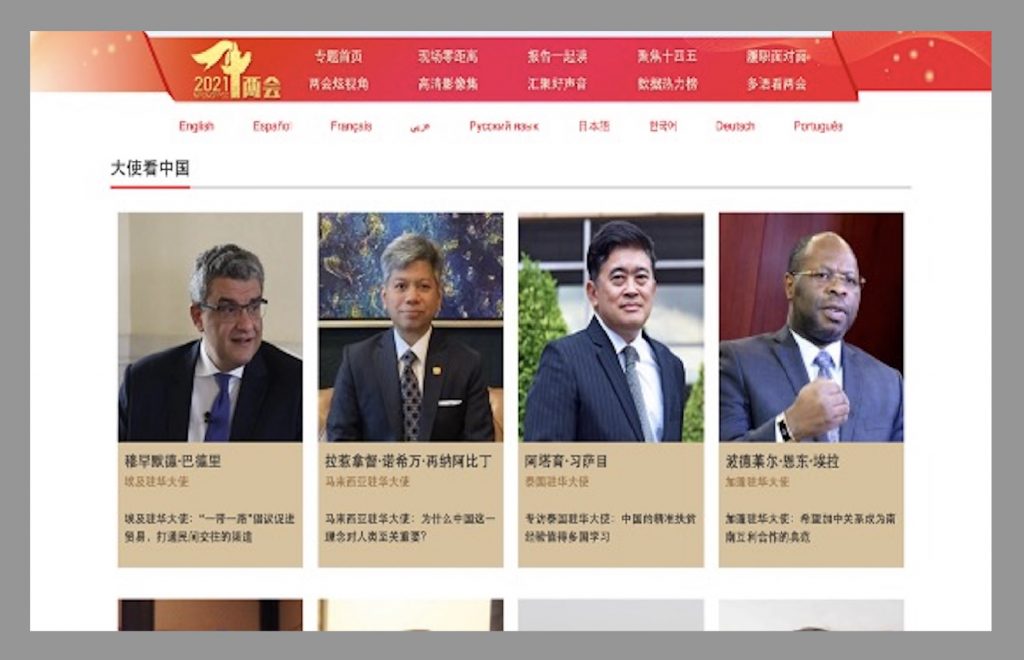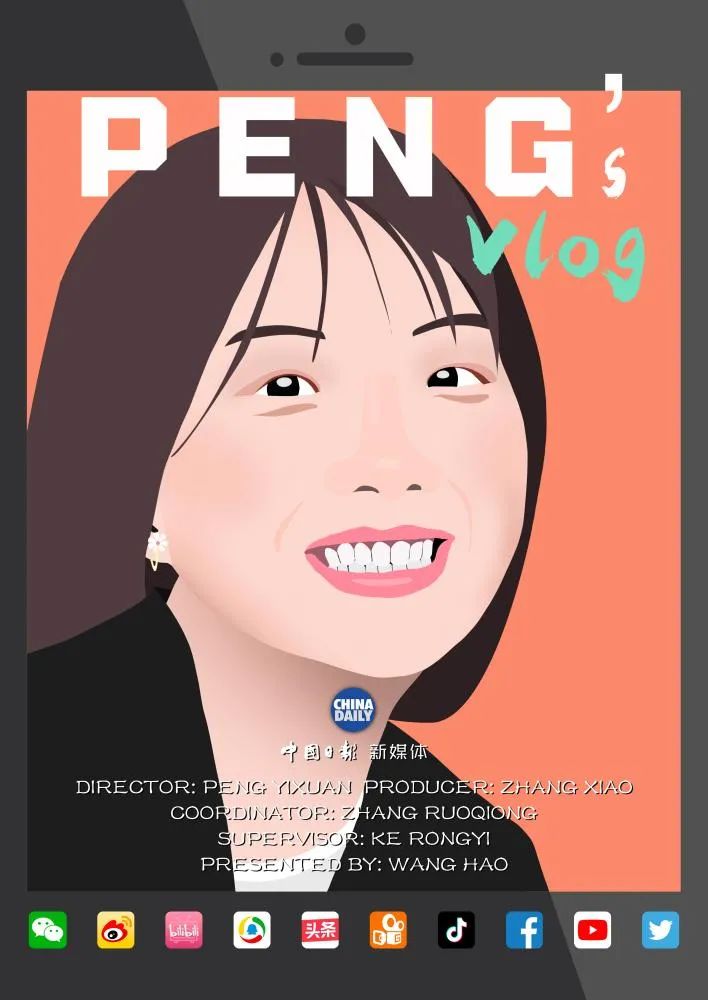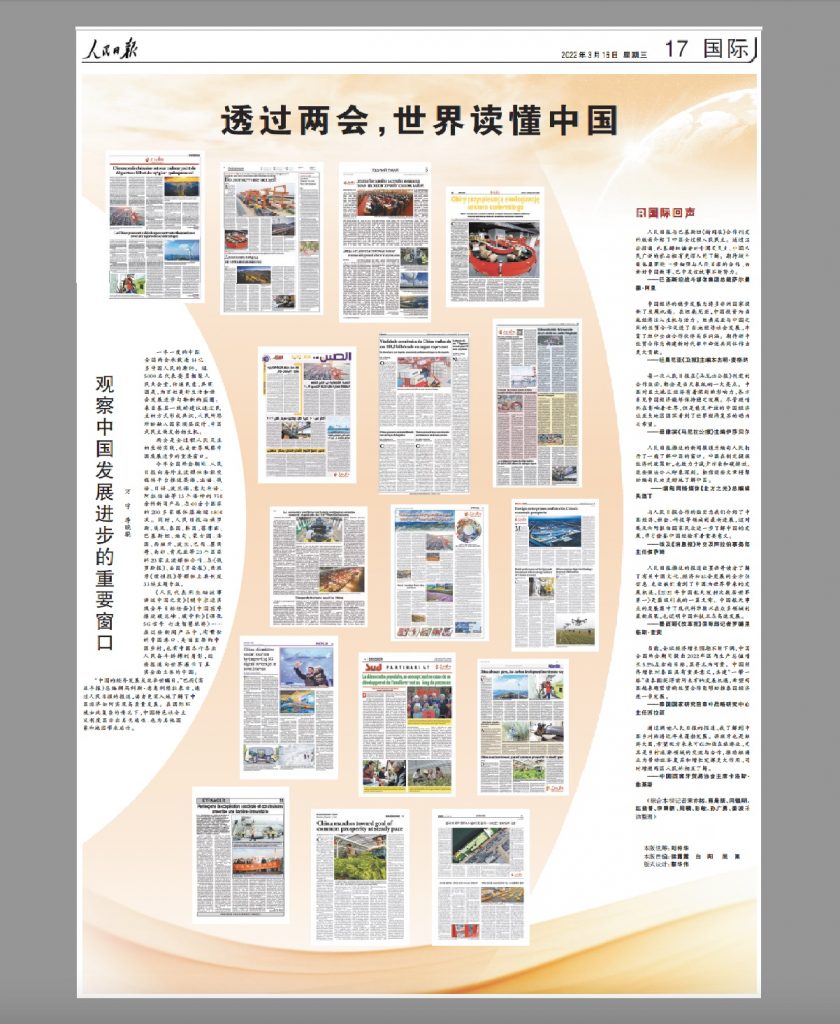Going Global
Tricks of the External Propaganda Trade

Above: The Great Hall of the People in Beijing, where the annual “two sessions” are held.Chinese state media are experimenting with newer media forms such as vlogs to make content about the “two sessions” more palatable to foreign audiences. Image by Jack Versloot available at Flickr.com under CC license.
China’s annual “two sessions” season has come to a close, and official state media today have splashed related news over their front pages and home pages. For its part, the official People’s Daily newspaper has published, across three pages, the official work report from the Standing Committee of the National People’s Congress (NPC), which lays out the work accomplished by the NPC over the past “milestone” year.
The “two sessions” are generally a time for review of key policies and legislation on the economy and other areas. The official work report, for example, notes that in 2021 the NPC passed 17 new laws, and amended 22 others. But another crucial role of the “two sessions,” generally less discussed, is its role in conducting external propaganda to attract overseas audiences and induce them to learn more about China’s development.
This role is no secret. In fact, it is something actively and openly encouraged in the Chinese media. In an article series called “Two Sessions Tricks” (两会看招) published to its official website last week, the All-China Journalists Association (ACJA) reviewed the different methods state media had used as the “two sessions” over more than a decade to actively enhance China’s international voice and “discourse power.” And following on coverage in 2021, the official People’s Daily offered a summary this week of all the external propaganda it saw fit to print in hundreds of overseas newspapers.
Let’s take look at related discussion this year of China’s external propaganda goals for the “two sessions.”
Borrowing Foreign Voices
One March 8 article in the ACJA series spoke of the tactic of “borrowing strength to fight with strength” (借力打力) – essentially the appropriation of authoritative voices to speak for China. It noted, for example, that in 2010 Xinhua News Agency launched an annual column called “Ambassadors Observing the Two Sessions” (大使看两会), which sought remarks from various foreign ambassadors stationed in China to highlight the country’s development and strengths. According to the ACJA article, this “innovative” approach earned Xinhua the second prize in the International Communication category at the 29th China Journalism Awards in November 2019.
Xinhua’s “innovation” with “Ambassadors Observing the Two Sessions” was simple: Sit foreign ambassadors down for short interviews in which they would offer broad comments about China’s economic development and issues discussed at the “two sessions.” The videos that resulted were complimentary without fail, praising the government and the Chinese Communist Party. Questions were pre-loaded with positive responses. In a 2018 interview, then Spanish Ambassador to China Alberto Carnero Fernández was asked: “What positive impacts has the Belt and Road Initiative had on the countries involved?”

The ambassador was obligingly positive, stressing the opening of markets, the creation of exchanges between companies in different regions, and “promoting linkages between China and Europe.” This despite real and growing differences in the EU-China relationship, then as now, regarding China’s larger geopolitical ambitions, and the fact that, as a report from the European Parliament noted, “so far the lion’s share of all BRI-related contracts have been awarded to Chinese companies.”
In many cases, ambassadors for the Xinhua series are selected because their countries have strong or developing economic interests with China – for example, BRI partners like Laos or Thailand. Or they are countries that have longstanding strategic relationships with China, such as Pakistan and Egypt.

The ACJA article on “external propaganda reports” (外宣报道) during the “two sessions” expressly mentions using the voices of foreign ambassadors to “respond positively to skeptical voices about China in the international public opinion arena.” Regarding the Xinhua series, it concludes: “On the theme of China and its relations with the world, it is better to let foreigners speak directly, which can better attract the attention of overseas audiences and enhance the credibility and persuasiveness of the content.”
Among the ambassadors speaking for this year’s “two sessions” was Cuban Ambassador to China Carlos Miguel Pereira, who told CCTV.com that “the two sessions has shown the strength of Chinese-style democracy.”
Old Message New Medium
In seeking to get China’s message out on the “two sessions,” state media have also turned to newer media forms more conducive to the era of viral social media content and trends like live streaming.
According to another article in the ACJA series on “Two Sessions Tricks,” vlogs on current affairs have been an experiment in “two sessions” reporting at state media since 2019. That year, the new media division of China Daily, the newspaper published by the Information Office of the State Council, launched “Peng’s Vlog,” which featured journalist Peng Yixuan (彭译萱). As Peng explains in the article: “During coverage of the “two sessions” in 2019, my colleagues, leaders and I decided at a brainstorming planning meeting to try to combine the vlog format, which was starting to become popular abroad at the time, with current affairs news coverage.”

According to the ACJA article, Peng’s first vlog entry on March 4, 2019, in which she personally introduced her process of reporting the “two sessions,” received more than six million shares overseas, and 300 thousand comments, “having relatively large broadcasting strength and influence.” The vlog, said the article, had been “widely discussed” in the industry and among scholars, with more than 400 related articles. The vlog won third prize that year in the Media Convergence category of the 30th China Journalism Awards.
When it comes impact overseas, there are often serious gaps between real results and stated successes among Chinese state media. CMP was unable to confirm the impact of the original “Peng’s Vlog” post from 2019. However, a similar “two sessions” vlog entry posted by Peng in May the next year received just 19,000 views on China Daily’s Facebook page, and an underwhelming 735 likes. Engagement numbers through the China Daily platform are not available for verification.
The vlog approach has continued at state media. This year, the tradition was carried on at China Daily by reporter Ouyang Shijia (欧阳诗嘉), who largely reads from a prepared script with typical statements pronouncing the effectiveness of government policies, cut in with panoramic drone shots and views from busy factory floors.

CGTN, the international arm of China’s state broadcaster, CCTV, has similarly rolled out its own vloggers for the “two sessions.” This year it was reporter Liang Si, who again read through a prepared English script, often with difficulty. (Admittedly, “the 5th annual session of the 13th National Committee of the Chinese People’s Political Consultative Conference” is a mouthful for anyone to say). Liang waded through the basics of the CPPCC, how many panels and so on, and its “expected total of 2,157 members,” of which “1,987 were in attendance.” Posted on March 4, 2022, to CGTN’s official YouTube account, the video received 733 views, and just 49 likes. Four people commented.
The ACJA article promoting vlogging as an effective “trick” for external propaganda talks about the form as a new challenge for reporters. “As a new form of news coverage of the two sessions, the current affairs vlog once again raises the requirements for journalists attending the sessions,” the article said. “This includes the ability to adapt to the new reporting environment and the ability to shoot and produce video logs.”
However, while some such vlogs, notably “Peng’s Vlog” posts from 2019 and 2020, like her so-called “personal two sessions diary,” attempted more informal styles, many vlogs from official state media intended for foreign audiences have retained the stiff, scripted feel that has been typical of much official coverage for many years. By contrast, Chinese-language vlogs for state media journalists on platforms like Bilibili have been more interesting – within the constraints, at least, of “two sessions” reporting.
In one vlog post, for example, Xinhua journalist Li Yuhui (李俞辉) focused away from the announcements and the dry mechanics of the “two sessions” and looked instead at how staff at a press conference systematically sterilized microphones provided to reporters who were called on. The vlog essentially follows the mainstream narrative about the government’s vigilant response to the containment of COVID-19, but does so in a way that at least offers a short and easily understandable glimpse from the scene.

Another official vlogger worth a glance to see how state media are trying to change with the times is Xinhua’s Zhang Yang (张扬), who focusses in one post on the colorful – though decidedly superficial – aspects of delegates to the NPC and CPPCC. She notes, for example, that NPC delegate Wang Yaping (王亚平), a Chinese cosmonaut, is not attending this year because she is, well, in outer space.
Back to the front lines of China’s global campaign to “tell the China story well” (讲好中国的故事), Xi Jinping’s catchphrase for the work of conducting external propaganda and raising China’s “discourse power” internationally, one of the most heavily funded campaigns during the annual “two sessions” is that conducted through China’s foreign missions.
Parachute Propaganda
The China Media Project reported last year on a global propaganda blitz the People’s Daily carried out during the “two sessions” period, in which it claimed to have successfully placed 750 unique articles in nearly 200 media outlets from more than 40 countries, and in 12 languages. The campaign was repeated this year, and is promoted today on page 17 of the newspaper, which includes 15 full-color layouts of China-related propaganda printed in foreign newspapers and magazines this month.
The examples include the French magazine l’Opinion, Poland’s left-leaning Dziennik Trybuna, Senegal’s French-language Sud Quotidien, an independent newspaper, and the Nigerian daily newspaper The Authority, a community newspaper owned by businessman Ifeanyi Ubah, who has strong business ties with China.

This year, the People’s Daily reports, its external propaganda drops during the “two sessions” totaled close to 4,800, achieved through the placement of 770 articles in more than 200 media in 60 countries and 13 languages. As we noted in last year’s analysis, the labeling of these drops is quite varied, with some outlets clearly labeling content as coming from the People’s Daily, and others making the source opaque or omitting it altogether.
Most, if not all, of the content published during this round of external propaganda drops is translated directly from prior People’s Daily reports, or is content already published through People’s Daily Online or related platforms. For example, the article published in The Authority, the Nigerian daily newspaper, is called, “China marches toward goal of common prosperity at steady pace.” This article is taken verbatim from the People’s Daily Online, and an identical article also appeared on the website of the official Seeking Truth journal. An identical article also appears in the bottom-third of a China-sponsored page in Nigeria’s Guardian newspaper. The article at the top of the page in the Guardian, “China advances green, low-carbon development in systematic way,” also previously appeared in identical form at People’s Daily Online on February 14 this year.
The People’s Daily does not reveal what the cost of this campaign might have been, as most of these drops would likely have been paid advertorials. But as we noted in last year’s analysis, this would likely represent a substantial ad buy, running to tens of millions of dollars. We noted that advertising rates for 2021 posted by the French magazine l’Opinion (one of the publications featured this year and last) show that full-page advertisements, depending on placement, run between 18,000 and 30,000 euros, or 21-36,000 US dollars.
Clearly, the “two sessions” are an external propaganda opportunity that the Chinese government is keen to exploit at virtually any cost.
Additional research by David L. Bandurski.





















